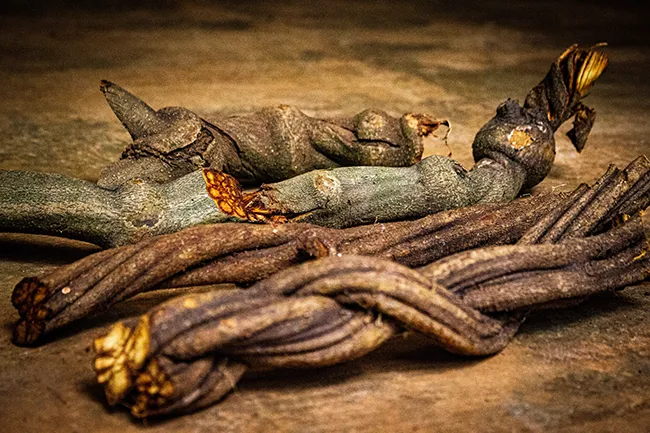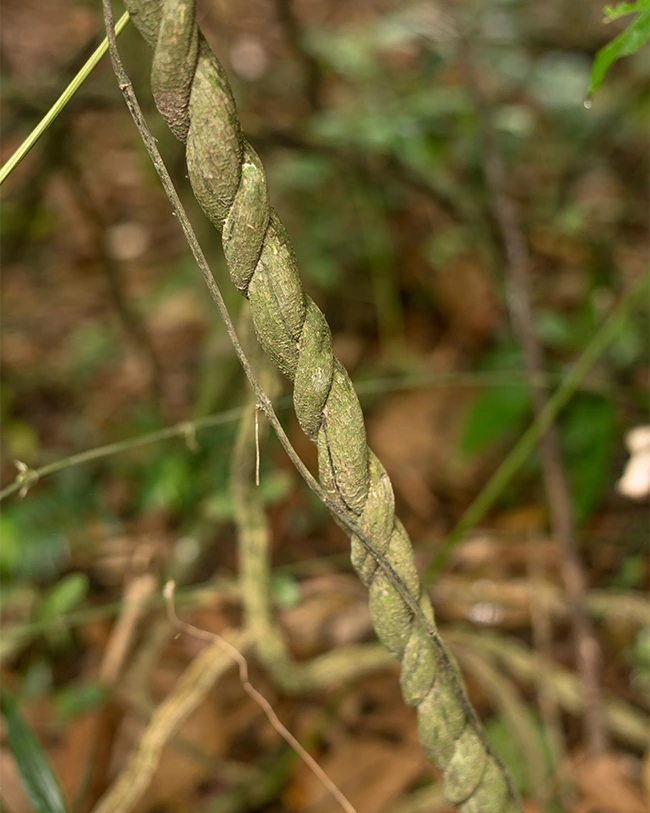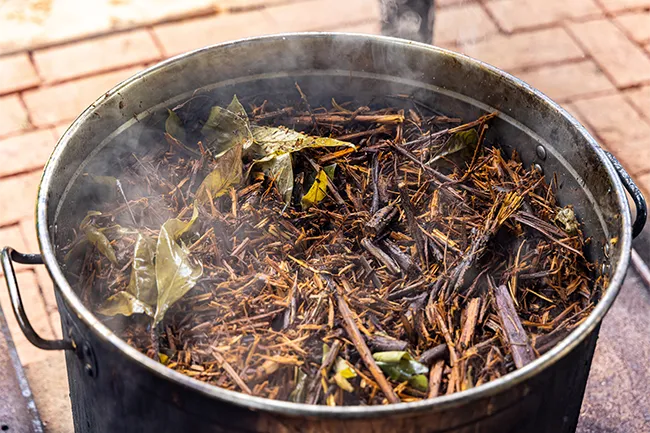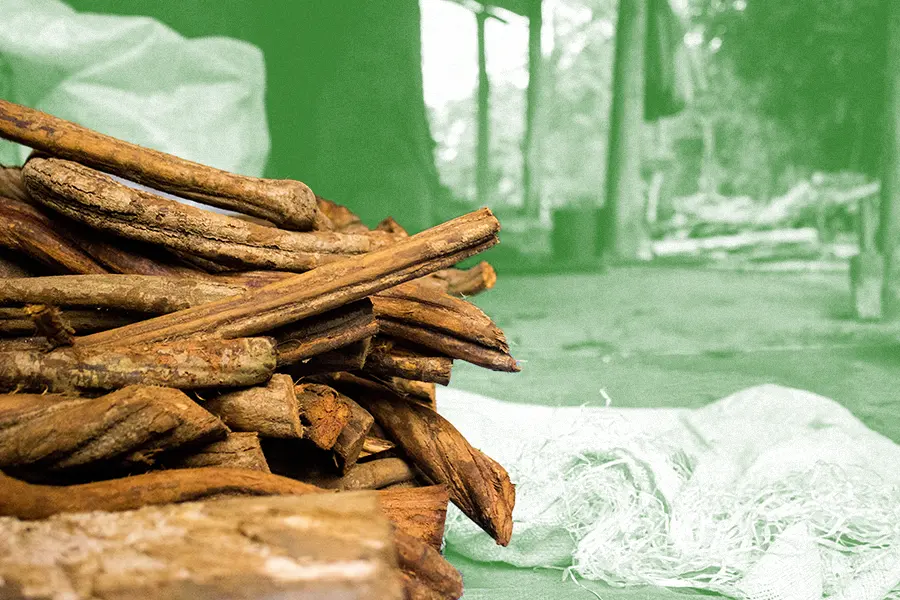Naya Oxe, an ayahuasca facilitator in California trained by the Peruvian Shipibo lineage, regularly microdoses the Banisteriopsis caapi plant. This vine is best known as an ingredient in the psychedelic ceremonial drink ayahuasca, but the plant has many names and meanings throughout the Amazon. It’s Yagé in Colombia; Ayahuasca in Peru. In English, it translates to the “vine of the soul.” Oxe takes the caapi plant by itself for its “antidepressant” effects. “It supports my mood … it opens your heart,” she says.1 “I’m more relaxed, more calm, more positive-thinking, less gloomy, and less self-critical.
Most people who have consumed the caapi plant have likely done so in the form of ayahuasca. Ayahuasca brews typically contain a mixture of Banisteriopsis caapi and the Psychotria viridis shrub (chacruna). The two plants work together synergistically, says James Giordano, professor of neurology and biochemistry at Georgetown University Medical Center.
The Science Behind the Ayahuasca Plant (the Vine of the Soul)
In an ayahuasca brew, the Psychotria viridis shrub provides dimethyltryptamine (DMT), which produces hallucinations, insights, and feelings of transcendence, says Giordano. In contrast, the Banisteriopsis caapi vine does not contain DMT. Instead, it contains a compound that acts as a monoaminoxidase inhibitor (MOAI), which stops the DMT from being broken down in the digestive tract and enables it to reach the brain. DMT is not orally active by itself; it becomes psychedelic when combined with an MAOI.
READ: How the Shipibo Came to Be the Most Common Group Serving Ayahuasca to Foreigners

When these two plants are mixed together to make ayahuasca, the psychedelic properties of DMT are enhanced—and you get some additional effects as well. Banisteriopsis caapi also releases norepinephrine, which “gives you a bit of a buzz,” as well as “serotonin, which gives you a feel-good effect, and dopamine, which gives you a reinforcing effect,” Giordano says. He adds that it might also spark neurogenesis—the development of new neurons—which could hold promise for treating strokes and brain injuries.
Translated from Kichwa, the ayahuasca vine is the “vine of the soul” or the “vine of death”—names that reference “the deep and transformative effects the plant can offer,” says Danny Santos, an ayahuasca shaman also initiated through the Shipibo tribe in Peru. (Shipibo tradition uses the term Ayahuasca and not Yagé.) By itself, caapi tends to be gentler than ayahuasca, creating a sense of positivity and alertness without a full-on trip, says Giordano. “Microdosing it produces a very subtle effect; you’d feel an increase in some of your cognitive faculties [and an] emotional uplift.” Jaime, a 42-year-old plant medicine guide and energy healer, says that microdosing the vine “connects me to and grounds me in the Earth and the cosmos so I feel integrated and interconnected with everything,” allowing for “insights, realizations, and knowings.”
The Banisteriopsis caapi plant is also partially responsible for ayahuasca’s purgative effects — that is, its ability to induce vomiting. Ayahuasca-induced nausea stems from a combination of increased serotonin activity and the effects of the DMT on the chemoreceptor trigger zone in the vomiting center in the medulla, a part of the brain that controls autonomic reflexes in the brain stem. The “purging” induced through ayahuasca is believed to offer benefits by “cleansing the liver, kidneys, blood, [and] major organs and flushing and detoxing the body through vomiting and diarrhea,” says Santos.
How to Grow Shrooms Bundle
Take Both of Our Courses and Save $90!
How the Ayahuasca Plant Is Used to Make Ayahuasca
Banisteriopsis caapi grows in the Amazon rainforest, most often in Peru, Brazil, Colombia, and Hawaii, according to Santos. “The vine can grow up to approximately 100 feet long and will hang on other plants and trees for support,” he explains. “The plant requires relatively high humidity to grow and grows best in sandy, loamy, and clay soils.” It comes in a variety of colors, which all have different spiritual uses.
Sometimes, Banisteriopsis caapi is ingested by itself at the beginning of an ayahuasca ceremony so that participants are primed to feel the effects of the ayahuasca, says Oxe. Jesus Dagua, president of the Sacha Wasi tribal community in Ecuador—which runs ayahuasca retreats—doesn’t normally serve Banisteriopsis caapi by itself but has done so to test someone’s reaction to it before determining whether they could handle the ayahuasca.
Have You Heard…?
“In 2016, the Union of Indigenous Yagé Doctors of the Colombian Amazon found itself in trouble. Colombia’s decades-long armed conflict continued to affect the five Indigenous pueblos who comprise the organization, complicating their mission to conserve their cultures and the ancestral plant medicine, yagé, that is central to them all…” Continue reading from Journalist Delilah Friedler.

Typically, those who make ayahuasca harvest both caapi and the chacruna shrub “in a deeply ceremonial and reverent way,” says Santos. “Curanderos often wake early in the morning before the sun rises, and while in deep intention and a prayerful state, commune with the plant spirits and must ask the permission of the plants in order to harvest with integrity. It is recommended to bring offerings to the plants in exchange for harvesting, such as glasses of water [and] tobacco blessings.”
Once it is mature, the Banisteriopsis caapi plant is harvested with a saw or clippers, then struck with a club to break it into smaller pieces, says Santos. “This is done while singing icaros, or Indigenous medicine songs, in order to imbue positive intentions into the brew.” Then, the pieces of the caapi plant are mixed with the chacruna leaves and boiled with water in a pot. A shaman watches the pot for three days, and sometimes other plants are added. “During my training with the Shipibo tribe in Peru, I would spend hours with the pot, periodically stirring it, blessing it with mapacho (Peruvian sacred tobacco), and singing icaros,” says Santos.
As the pot’s contents reduce, they get moved to smaller and smaller pots, going from 20-30 gallons to two liters. “A lot of the ayahuasca vine is required to make such a small amount of medicine,” says Santos. “Particular attention is paid to the atmosphere around the pot—no negative conversations or bad energy should be around the brew during this phase, as these energies are believed to seep into the ayahuasca, leading to negative experiences during an ayahuasca ceremony.”
Precautions When Consuming Banisteriopsis Caapi
People with cardiac disease, severe anxiety disorders (i.e., frequent anxiety attacks), or blood pressure problems should avoid consuming the Banisteriopsis caapi plant by itself or as ayahuasca, says Giordano, along with those who are on antidepressants or MAO inhibitor drugs.
A class of antidepressants called serotonin reuptake inhibitors (SSRIs), including Prozac and Zoloft, are particularly problematic because they increase the amount of serotonin in your brain. Combined with the serotonin-stimulating effects of Banisteriopsis caapi, this can lead to serotonin syndrome, a “highly pathological” state involving shaking, impaired temperature regulation, and agitation, says Giordano. “It’s a clinical emergency.” Talk to your doctor before consuming Banisteriopsis caapi if you are on any medication; you may have to be off your medication for a while before it’s safe.
The Vine of the Soul: Conservation and Tradition
When benefiting from the caapi plant’s medicinal properties, it’s also important to consider how you can give back to the plant itself.2 “Currently, it is not on [the] endangered species list and has wide and broad distribution throughout the Amazon,” says Leslie Korn, Director of Research and Education at the Center for World Indigenous Studies. “However, the ongoing destruction of the rainforest and incursion into Indigenous people’s territories threaten all medicinal plants, and a cautious approach must be enacted to protect the rights and resources of Indigenous peoples.”
READ: There’s a Worldwide Spike in Arrests of Plant Medicine Practitioners

Banisteriopsis caapi has been over-harvested in Peru to the point that the supply is running out, largely because of tourists and people who are exporting the plant to North America and Europe, according to Dagua. To make sure that the same does not happen where he lives in Ecuador, the Sacha Wasi retreat center has an adopt-a-vine program where you can donate $20 for a vine to be planted in your name or the name of someone you’d like to honor. It takes about 15 years for a vine to be harvestable, so your adopted vine will be used for future Ayahuasca retreats.
Oxe also advises “not over-consuming, and not approaching this medicine with a Western mentality of ‘more is better’” so that you do not use up more of the Ayahuasca (Yagé) vine than is necessary.
Spiritual Beliefs About the Ayahuasca Plant
In Dagua’s tribe and many tribes that work with Ayahuasca, the spirit of “mother Ayahuasca” is thought to reside within the caapi plant. The plant is also a messenger through which to communicate with other divine beings. “We connect with the spirits of the plants and with the spirit of Mother Earth and Father Sky,” Dagua says.
In visions, mother ayahuasca will commonly appear as a jaguar or an anaconda, but she can also appear as a religious figure like Jesus or the Buddha to people from those traditions. It’s also important to remember that shamanic plants, including the caapi plant, have different meanings to different cultures throughout the Amazon. The plant is a part of many different cosmologies. There are different preparations, too: Yagé and Ayahuasca both refer to the same plant and similar brews. But, how the caapi plant is prepared varies by culture and region.
Dagua believes it’s important to do ayahuasca in nature in order to best connect with the spirit of the plant — and it’s even better if you can get out in nature before and after the ceremony. “Being in nature helps you connect to pacha mama [Mother Earth], and that way, she gets to know you better so you can have a much more powerful healing experience,” he says. “To make the most of your experience, first you need to have your mind clear enough, to have love and peace, to give love to nature, and to give love back to the medicine.” Listening to music that was played during the ceremony can also help you connect with the plant after you get back, he adds.
Oxe, whose Shipibo lineage considers the caapi plant a “master teacher plant,” recommends working with a facilitator who is from or has been trained by an Indigenous tribe to ensure that the customs around the plant are honored. “Respecting the tradition would definitely include education around these traditions,” she says. “Just like any medicine, it should not be abused, and people should really think about not just the conservation but harmony with the ecosystem. Understand the wider cultural and economic scope where this plant comes from.”
- This article focuses more on Ayahuasca traditions than Yagé traditions. However, we include both names because issues that impact the caapi plant and its stewards span many cultures. However, some regions may be impacted by overharvesting, mining, and violence more than others. ↩︎
Love our article on the ayahuasca plant? Deepen your learning here
Ayahuasca can be incredibly healing, but it remains unaffordable to many who might benefit. DoubleBlind’s co-founder and Editor-in-Chief covers the high cost of accessing spiritual care.
Indigenous communities in the Amazon predicted the destruction before a single bulldozer plowed through the rainforest. Photojournalist Nicola Ókin spent has been documenting their resistance since 2016.
Huni Kuin women are cultural leaders in plant medicine—but they haven’t been seen. Now, they’ve formed an association of their own.

DoubleBlind is a trusted resource for news, evidence-based education, and reporting on psychedelics. We work with leading medical professionals, scientific researchers, journalists, mycologists, indigenous stewards, and cultural pioneers. Read about our editorial policy and fact-checking process here.

DoubleBlind Magazine does not encourage or condone any illegal activities, including but not limited to the use of illegal substances. We do not provide mental health, clinical, or medical services. We are not a substitute for medical, psychological, or psychiatric diagnosis, treatment, or advice. If you are in a crisis or if you or any other person may be in danger or experiencing a mental health emergency, immediately call 911 or your local emergency resources. If you are considering suicide, please call 988 to connect with the National Suicide Prevention Lifeline.



